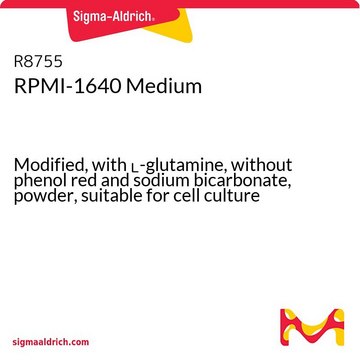Wichtige Dokumente
R7638
RPMI-1640-Medium
Dutch Modification, with sodium bicarbonate and HEPES, without ʟ-glutamine, liquid, sterile-filtered, suitable for cell culture
Synonym(e):
Roswell Park Memorial Institute 1640 medium
About This Item
Empfohlene Produkte
Produktbezeichnung
RPMI-1640-Medium, Dutch Modification, with sodium bicarbonate and 20mM HEPES, without L-glutamine, liquid, sterile-filtered, suitable for cell culture
Qualitätsniveau
Sterilität
sterile-filtered
Form
liquid
Methode(n)
cell culture | mammalian: suitable
Verunreinigungen
endotoxin, tested
pH-Wert
>7.2
Komponenten
sodium pyruvate: no
HEPES: 20 mM
L-glutamine: no
NaHCO3: yes
phenol red: yes
Versandbedingung
ambient
Lagertemp.
2-8°C
Suchen Sie nach ähnlichen Produkten? Aufrufen Leitfaden zum Produktvergleich
Allgemeine Beschreibung
Anwendung
- to obtain spleen and lymph nodes from mice
- for the resuspension of Staphylococcus aureus strains in the phagocytosis assay
- in the isolation of hepatitis B surface antigen-specific B-cell clones
Rekonstituierung
Ergänzung
auch häufig zusammen mit diesem Produkt gekauft
Lagerklassenschlüssel
12 - Non Combustible Liquids
WGK
WGK 1
Flammpunkt (°F)
Not applicable
Flammpunkt (°C)
Not applicable
Hier finden Sie alle aktuellen Versionen:
Besitzen Sie dieses Produkt bereits?
In der Dokumentenbibliothek finden Sie die Dokumentation zu den Produkten, die Sie kürzlich erworben haben.
Kunden haben sich ebenfalls angesehen
Unser Team von Wissenschaftlern verfügt über Erfahrung in allen Forschungsbereichen einschließlich Life Science, Materialwissenschaften, chemischer Synthese, Chromatographie, Analytik und vielen mehr..
Setzen Sie sich mit dem technischen Dienst in Verbindung.






